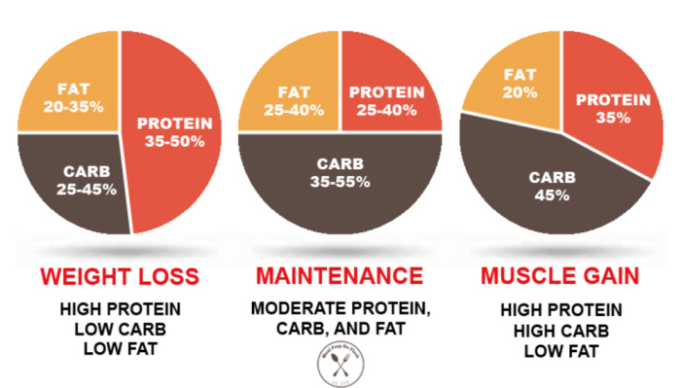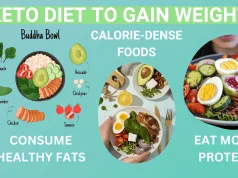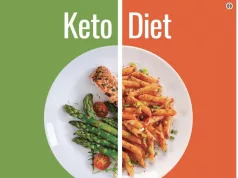The best diet for weight loss and muscle gain isn’t a one-size-fits-all solution. It’s about understanding your individual needs and preferences, crafting a sustainable plan that aligns with your goals, and consistently implementing it. This means considering your activity level, body composition, and personal dietary preferences, as well as the science behind achieving both weight loss and muscle gain.
We’ll delve into the crucial role of calorie balance, exploring how to achieve a deficit for weight loss while ensuring adequate intake for muscle building. We’ll then discuss macronutrient distribution, highlighting the importance of protein, carbohydrates, and fats for optimal results.
This will be followed by practical strategies for building muscle through weight training and the significance of rest and recovery. Finally, we’ll explore specific food choices that support both weight loss and muscle gain, along with tips for making sustainable lifestyle changes.
The Myth of “Best Diet”: The Best Diet For Weight Loss And Muscle Gain
The quest for the perfect diet is a common pursuit, but the truth is, there’s no single “best” diet that works for everyone. Just like every individual has a unique set of genes, lifestyle, and health goals, their dietary needs are also unique.
Individual Needs and Preferences
What works for one person may not work for another. Factors such as age, activity level, medical conditions, food allergies, cultural background, and personal preferences all play a significant role in determining the most effective dietary approach.
Different Dietary Approaches
There are numerous dietary approaches that have been studied and touted for their effectiveness in weight loss and muscle gain. Here are some examples:
Calorie Restriction
Calorie restriction involves consuming fewer calories than your body burns, creating a calorie deficit that leads to weight loss. This is a common strategy used in many weight loss programs.
Intermittent Fasting
Intermittent fasting involves cycling between periods of eating and fasting. It doesn’t specify what you eat, but rather when you eat. Popular methods include the 16/8 method (fasting for 16 hours and eating within an 8-hour window) and the 5:2 method (eating normally for 5 days and restricting calories to 500-600 for 2 days).
Macronutrient Manipulation
Macronutrient manipulation involves adjusting the proportions of carbohydrates, proteins, and fats in your diet. For example, a high-protein diet emphasizes protein intake to support muscle growth and satiety. A low-carb diet restricts carbohydrate intake, potentially leading to weight loss and improved blood sugar control.
Calorie Balance
To achieve your weight loss and muscle gain goals, understanding calorie balance is crucial. It’s the foundation for managing your weight and building muscle effectively.
Calorie balance refers to the relationship between the calories you consume and the calories you burn. When you consume more calories than you burn, you gain weight. Conversely, when you burn more calories than you consume, you lose weight.
Calorie Deficit for Weight Loss
A calorie deficit is the key to losing weight. It occurs when you consume fewer calories than your body needs to maintain its current weight. The difference between your calorie intake and your calorie expenditure creates a deficit, leading to weight loss.
Calorie Intake Recommendations
The number of calories you need daily depends on various factors, including your activity level, body composition, and individual metabolism. Here’s a table that provides a general guideline for different activity levels and body compositions:
| Activity Level | Body Composition | Estimated Daily Calorie Intake |
|---|---|---|
| Sedentary | Lean | 1,600
|
| Sedentary | Average | 1,800
|
| Moderately Active | Lean | 2,000
|
| Moderately Active | Average | 2,200
|
| Very Active | Lean | 2,400
|
| Very Active | Average | 2,600
|
Role of Exercise in Calorie Deficit
Exercise plays a vital role in creating a calorie deficit. It helps you burn more calories, contributing to weight loss. Engaging in regular physical activity increases your overall calorie expenditure, making it easier to achieve a deficit.
A calorie deficit is achieved when you consume fewer calories than your body needs to maintain its current weight.
While a balanced diet is key for weight loss and muscle gain, it’s important to remember that exercise plays a crucial role. However, if you’re looking for alternative approaches, you might be interested in exploring How to lose weight without exercise and diet.
While it’s not a replacement for a healthy lifestyle, it can offer valuable insights into other factors that influence weight management. Ultimately, the best diet for weight loss and muscle gain should be personalized and tailored to your individual needs and goals.
Macronutrient Distribution
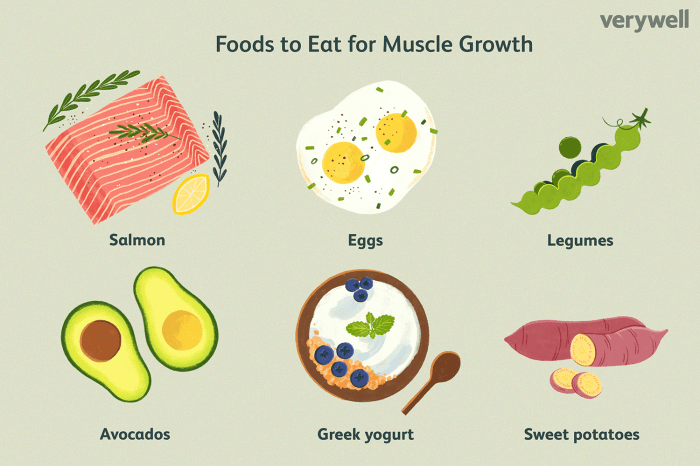
The ratio of macronutrients (protein, carbohydrates, and fats) you consume plays a crucial role in both weight management and muscle building. While the ideal ratio varies depending on individual goals, activity levels, and other factors, understanding the role of each macronutrient can help you create a balanced diet for your specific needs.
Role of Macronutrients in Weight Management and Muscle Building
- Protein: Essential for building and repairing muscle tissue. It also promotes satiety, helping you feel fuller for longer and potentially reducing overall calorie intake.
- Carbohydrates: Your body’s primary energy source, providing fuel for workouts and daily activities. Choosing complex carbohydrates over simple sugars can help stabilize blood sugar levels and provide sustained energy.
- Fats: Important for hormone production, cell function, and nutrient absorption. Healthy fats, such as those found in avocados, nuts, and olive oil, can also help with satiety and may contribute to muscle growth.
Recommended Macronutrient Ratios
- For Weight Loss: A common recommendation for weight loss is to consume a higher protein intake, moderate carbohydrate intake, and a lower fat intake. This can help promote satiety, preserve muscle mass, and support a calorie deficit. A typical ratio might be 30-40% protein, 30-40% carbohydrates, and 20-30% fat.
- For Muscle Gain: For muscle growth, you’ll need to consume more calories, including adequate protein to support muscle protein synthesis. A common recommendation is 1.6-2.2 grams of protein per kilogram of body weight per day. A typical ratio for muscle gain might be 40-50% protein, 30-40% carbohydrates, and 20-30% fat.
Food Sources for Macronutrients
| Macronutrient | Food Sources |
|---|---|
| Protein | Lean meats (chicken, turkey, fish), eggs, dairy products (milk, yogurt, cheese), beans, lentils, tofu, quinoa, nuts, and seeds. |
| Carbohydrates | Whole grains (brown rice, quinoa, oats), fruits, vegetables, legumes, and starchy vegetables (potatoes, sweet potatoes). |
| Fats | Avocado, nuts, seeds, olive oil, fatty fish (salmon, tuna, mackerel), and eggs. |
Muscle Building Strategies
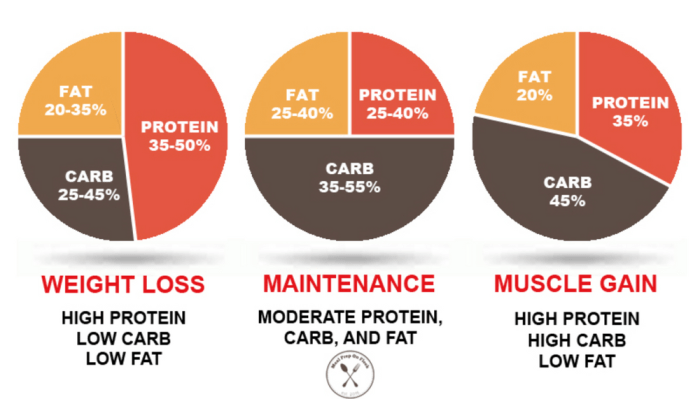
Building muscle is a crucial aspect of achieving a healthy body composition and enhancing overall fitness. It requires a combination of effective weight training exercises, proper nutrition, and adequate rest.
Effective Weight Training Exercises
Weight training exercises are essential for stimulating muscle protein synthesis, which leads to muscle growth. Here are some effective exercises for different muscle groups:
- Chest:Bench press, dumbbell flyes, push-ups
- Back:Pull-ups, rows, lat pulldowns
- Legs:Squats, lunges, deadlifts, leg press
- Shoulders:Overhead press, lateral raises, front raises
- Arms:Bicep curls, tricep extensions, hammer curls
Importance of Progressive Overload and Proper Form
Progressive overload is a fundamental principle of weight training. It involves gradually increasing the weight, repetitions, or sets over time to challenge your muscles and promote growth. Proper form is crucial for maximizing results and minimizing the risk of injuries.
“To stimulate muscle growth, you need to consistently challenge your muscles with progressively heavier weights or more repetitions.”
Role of Rest and Recovery in Muscle Growth
Rest and recovery are equally important as training for muscle growth. During rest, your body repairs and rebuilds muscle tissue. Aim for at least 1-2 days of rest between weight training sessions to allow your muscles to recover.
Food Choices for Optimal Results
Fueling your body with the right nutrients is crucial for both weight loss and muscle gain. This involves prioritizing nutrient-rich foods that provide the necessary building blocks for muscle growth and energy expenditure for weight loss.
Nutrient-Rich Foods for Weight Loss and Muscle Gain
- Lean Protein:Protein is essential for muscle growth and repair. Choose lean protein sources like chicken breast, fish, turkey, tofu, beans, and lentils.
- Complex Carbohydrates:Complex carbohydrates provide sustained energy and help regulate blood sugar levels. Opt for whole grains, brown rice, quinoa, sweet potatoes, and fruits.
- Healthy Fats:Healthy fats are crucial for hormone production and cell function. Include sources like avocado, nuts, seeds, olive oil, and fatty fish.
- Vegetables:Vegetables are packed with vitamins, minerals, and fiber, which support overall health and satiety. Aim for a variety of colorful vegetables.
- Fruits:Fruits provide vitamins, minerals, and antioxidants, contributing to overall health and energy levels. Choose whole fruits over processed fruit juices.
Recipes for Weight Loss and Muscle Gain, The best diet for weight loss and muscle gain
- Grilled Salmon with Roasted Vegetables:This recipe combines lean protein from salmon with fiber-rich roasted vegetables like broccoli, carrots, and bell peppers. The combination provides essential nutrients for muscle growth and satiety.
- Chicken Breast Stir-Fry with Brown Rice:This quick and easy meal includes lean protein from chicken breast, complex carbohydrates from brown rice, and vegetables like broccoli, carrots, and snap peas for added vitamins and minerals.
- Quinoa Salad with Grilled Chicken and Avocado:This salad offers a balance of protein, complex carbohydrates, and healthy fats. The quinoa provides essential amino acids, while the chicken and avocado contribute to muscle growth and satiety.
Importance of Hydration
Water plays a vital role in weight management and muscle growth. It helps regulate body temperature, transport nutrients, and remove waste products. Adequate hydration is crucial for optimal performance and recovery.
“Aim to drink at least 8 glasses of water per day.”
Sustainable Lifestyle Changes
The key to long-term success in weight loss and muscle gain is adopting sustainable lifestyle changes. This means making gradual adjustments to your diet and exercise habits that you can maintain over time. Trying to overhaul your entire lifestyle overnight is often unsustainable and can lead to burnout and setbacks.
Making Gradual Changes
Making small, manageable changes to your diet and exercise routine is more likely to lead to lasting results. Instead of eliminating all processed foods at once, start by cutting back on one unhealthy snack or drink per day. Similarly, instead of joining a gym and working out for an hour every day, start with two 15-minute walks per week and gradually increase the intensity and duration of your workouts.
Overcoming Obstacles
Cravings
Cravings are a common challenge for those trying to make dietary changes. Instead of trying to completely avoid your favorite unhealthy foods, try incorporating them in moderation as part of a balanced diet. You can also find healthier alternatives to your favorite treats, such as swapping out sugary sodas for sparkling water with a squeeze of lemon.
Lack of Motivation
Staying motivated can be difficult, especially when you’re not seeing immediate results. Setting realistic goals, finding an exercise buddy, and rewarding yourself for progress can help keep you on track.
Benefits of Enjoyable Activities
Incorporating enjoyable activities into your healthy lifestyle is crucial for long-term success. If you hate running, don’t force yourself to do it. Find an activity you enjoy, such as dancing, swimming, or hiking. This will make it more likely that you’ll stick with your healthy habits.
Social Support
Having a strong support system can make a significant difference in your weight loss and muscle gain journey. Surround yourself with people who encourage your healthy choices and celebrate your successes. Consider joining a fitness class or support group to connect with others who share your goals.
Ending Remarks
Ultimately, achieving weight loss and muscle gain is a journey that requires patience, consistency, and a holistic approach. It’s not just about following a specific diet; it’s about embracing a healthy lifestyle that includes regular exercise, mindful eating, and adequate rest.
Remember, there’s no magic bullet, but with dedication and the right strategies, you can achieve your desired results and build a stronger, healthier you.
Question Bank
What are some common mistakes people make when trying to lose weight and gain muscle?
Common mistakes include: drastically restricting calories, skipping meals, focusing solely on cardio, neglecting protein intake, and not prioritizing rest and recovery.
How often should I eat to support weight loss and muscle gain?
The frequency of meals depends on individual preferences and schedules. However, aiming for 3-5 meals per day can help maintain consistent energy levels and support muscle recovery.
Can I gain muscle without lifting weights?
While weight training is the most effective way to build muscle, you can still build some muscle through bodyweight exercises, resistance bands, and other forms of resistance training.
How long does it take to see results from a diet and exercise plan?
The timeframe for noticeable results varies depending on individual factors, but consistent effort over several weeks to months is generally required.















